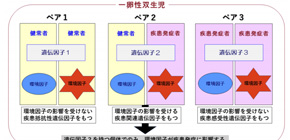
Immune diseases inflict identical twins differently
Osaka University scientists explain why only one identical twin is at risk for autoimmune diseases
It does not matter if you raise them the same, feed them the same, or dress them the same, any parent with identical twins knows their two children are remarkably different. Identical twins are identical in genes, but they are not identical in gene expressions, a difference due to epigenetics. Epigenetics also make twins different in their susceptibility to disease. A new study by researchers at the Osaka University Graduate School of Medicine reports which epigenetic factors in certain chromosomes that make one twin more at risk for autoimmune thyroid diseases. The study can be read in Thyroid.
The thyroid is one of the critical centers for hormone production in the body. It has a fundamental role in the body’s metabolism and other functions such as sleep and menstruation. Abnormalities in the thyroid are associated with an assortment of diseases, including autoimmune thyroid diseases, such as Grave’s disease and Hashimoto’s disease. In these diseases, the body produces anti-thryoglobulin autoantibodies that cause the immune system to attack the patient.
Associate Professor Watanabe is researching new diagnostics by studying the epigenome of identical twins. Working with the Center for Twin Research at Osaka University, his group found 23 identical twins that were discordant for the production of anti-thyroglobulin autoantibodies and sought to find the genetic and epigenetic causes.
“We hypothesized there are differences in the methylation of CpG sites. The methylation of CpG sites regulates gene expressions. Some diseases like type 1 diabetes show abnormal methylation patterns,” says Watanabe.
The methylation of CpG sites is a fundamental form of epigenetic regulation that occurs throughout the body. Indeed, his team found the methylation of CpG sites differed in the discordant pairs with the particular genotypes of 4 polymorphisms.
“The chromosomes containing these polymorphisms were not the same as the chromosomes containing genes associated with the susceptibility of autoimmune thyroid diseases. The genes susceptible to genetic factors and epigenetic factors are different,” Watanabe explains.
He says the study demonstrates the complexity in diagnosing metabolic diseases like thyroid disorders.
“Looking at only the genes is not enough. We need to study the genetics and epigenetics to determine the risk.”

Figure: We can analyze the individual differences in sensitivity to environmental factors using monozygotic twins. (Credit: Center for Twin Research, Osaka University Graduate School of Medicine)
To learn more about this research, please view the full research report entitled " Genotype-based epigenetic differences in monozygotic twins discordant for positive anti-thyroglobulin autoantibodies " at this page of Thyroid .
Related links
